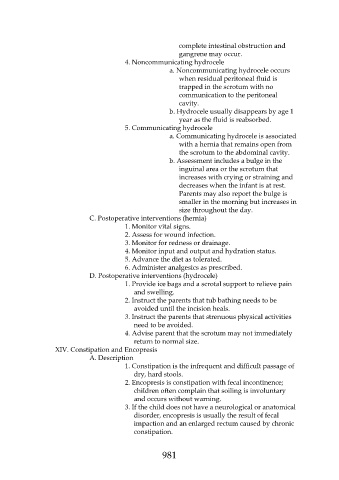Page 981 - Saunders Comprehensive Review For NCLEX-RN
P. 981
complete intestinal obstruction and
gangrene may occur.
4. Noncommunicating hydrocele
a. Noncommunicating hydrocele occurs
when residual peritoneal fluid is
trapped in the scrotum with no
communication to the peritoneal
cavity.
b. Hydrocele usually disappears by age 1
year as the fluid is reabsorbed.
5. Communicating hydrocele
a. Communicating hydrocele is associated
with a hernia that remains open from
the scrotum to the abdominal cavity.
b. Assessment includes a bulge in the
inguinal area or the scrotum that
increases with crying or straining and
decreases when the infant is at rest.
Parents may also report the bulge is
smaller in the morning but increases in
size throughout the day.
C. Postoperative interventions (hernia)
1. Monitor vital signs.
2. Assess for wound infection.
3. Monitor for redness or drainage.
4. Monitor input and output and hydration status.
5. Advance the diet as tolerated.
6. Administer analgesics as prescribed.
D. Postoperative interventions (hydrocele)
1. Provide ice bags and a scrotal support to relieve pain
and swelling.
2. Instruct the parents that tub bathing needs to be
avoided until the incision heals.
3. Instruct the parents that strenuous physical activities
need to be avoided.
4. Advise parent that the scrotum may not immediately
return to normal size.
XIV. Constipation and Encopresis
A. Description
1. Constipation is the infrequent and difficult passage of
dry, hard stools.
2. Encopresis is constipation with fecal incontinence;
children often complain that soiling is involuntary
and occurs without warning.
3. If the child does not have a neurological or anatomical
disorder, encopresis is usually the result of fecal
impaction and an enlarged rectum caused by chronic
constipation.
981

